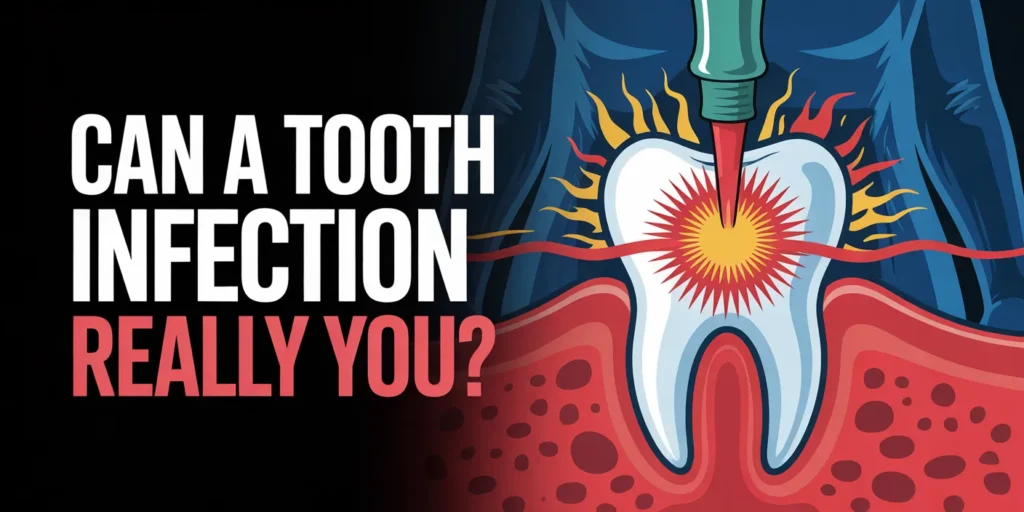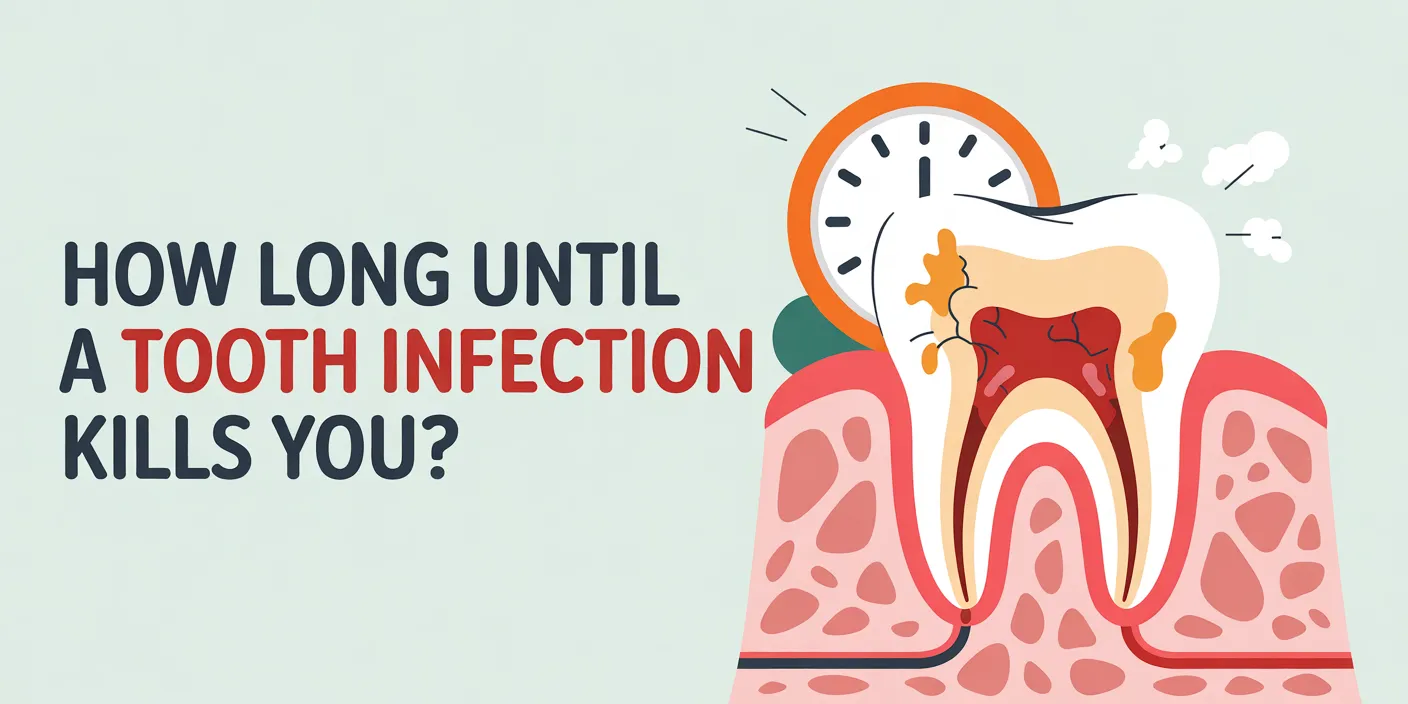Toothaches are annoying, sure — but deadly? It might sound dramatic, yet in rare cases, a simple tooth infection can spiral into something far more serious. Left untreated, the bacteria causing that dull throb in your jaw can spread to your bloodstream, leading to life-threatening complications like sepsis. So naturally, one alarming question arises: how long until a tooth infection kills you? In this article, we’ll break down the timeline, symptoms, risks, and when it’s time to take that pain very seriously.
What Is a Tooth Infection?
A tooth infection, also known as a dental abscess, occurs when bacteria invade the dental pulp — the soft tissue inside your tooth that contains nerves and blood vessels. This usually happens as a result of untreated tooth decay, gum disease, or a cracked tooth. Once the bacteria reach the pulp, they multiply, creating pus and pressure that leads to pain and swelling.
There are three main types of tooth infections:
- Periapical abscess – forms at the tip of the tooth root
- Periodontal abscess – occurs in the gums, near the tooth
- Gingival abscess – affects the gum tissue only
If left untreated, the infection can spread beyond the mouth — potentially to the jaw, neck, or even vital organs through the bloodstream. This is why understanding the signs and treating a tooth infection early is critical.
How Fast Can a Tooth Infection Spread?
A tooth infection might start small, but if left untreated, it can spread surprisingly fast — sometimes within just a few days. Once bacteria enter the bloodstream, the infection can travel to other parts of the body, including the jawbone (osteomyelitis), sinuses, or even lead to sepsis, a potentially fatal condition.
🧬 Typical Spread Timeline:
- Day 1–3: Localized pain and swelling around the affected tooth
- Day 4–7: Infection may spread to surrounding gum tissue and bone
- After 7 days: If untreated, bacteria can reach the bloodstream and cause systemic infection
In some cases, especially in people with weakened immune systems, the progression can be much faster. That’s why dental infections should never be ignored — they’re not just about toothaches; they’re potential gateways to serious health risks.
Can a Tooth Infection Really Kill You?

While it’s rare, the answer is yes — a tooth infection can be fatal if it’s left untreated. What starts as a simple dental issue can turn into a life-threatening emergency once the bacteria break out of the tooth and enter the bloodstream, spreading to other parts of the body.
One of the most serious outcomes is sepsis, a potentially deadly immune response to infection that can lead to organ failure and death. Other fatal complications from untreated dental infections include:
- Ludwig’s angina – a fast-spreading infection in the floor of the mouth and neck
- Brain abscesses – if the infection travels upward through the sinuses
- Endocarditis – infection of the heart lining
⚰️ Real-Life Case Examples:
- In 2007, a 12-year-old boy in Maryland died after a tooth infection spread to his brain.
- In 2020, several ER case reports showed patients developing sepsis from delayed dental treatment during lockdowns.
While these outcomes are rare, they’re a sobering reminder that oral health is directly tied to overall health — and delaying treatment can cost more than just a tooth.
Symptoms That a Tooth Infection Is Getting Dangerous
Most tooth infections start with mild discomfort — but certain symptoms signal that the infection is no longer just dental and may be turning into a medical emergency.
🚨 Watch for These Serious Symptoms:
- High fever and chills
- Swelling in the face, jaw, or neck
- Difficulty swallowing or breathing
- Rapid heartbeat or low blood pressure
- Severe, throbbing pain that spreads to the ear or jaw
- Foul taste in the mouth or persistent bad breath
- Redness or warmth in the face or neck
These symptoms may indicate that the infection is spreading into your lymph nodes, bloodstream, or airway — and can quickly escalate to conditions like sepsis or Ludwig’s angina.
If you experience any of these signs, seek immediate medical attention — not just a dentist, but an emergency doctor. Time is critical when a localized infection begins affecting your whole body.
If you suspect you have a tooth infection, don’t wait for the pain to worsen. Early treatment is key to preventing the infection from becoming dangerous or even life-threatening.
🚑 Signs It’s Time to See a Doctor:
- Severe, unrelenting pain that doesn’t improve with over-the-counter painkillers
- Swelling or redness in the face or gums that keeps spreading
- Fever above 101°F (38.3°C)
- Difficulty opening your mouth or swallowing
- Visible abscess or pus near the infected tooth
Even if the symptoms are mild, it’s still crucial to get checked out by a dentist or doctor. A dental professional can drain the abscess, prescribe antibiotics, and help prevent the infection from spreading. In some cases, surgery or a root canal may be required to eliminate the infection at its source.
🏥 Emergency Care vs. Routine Check-Up:
If you’re facing any of the severe symptoms mentioned, don’t hesitate to visit the emergency room. Don’t wait for the pain to become unbearable, as the infection can escalate quickly.
🕒 Timeline: From Toothache to Emergency
A tooth infection doesn’t always start as an emergency, but it can quickly escalate if left untreated. Here’s a typical timeline of how a tooth infection progresses — and why immediate attention is so critical:
🗓️ 0–3 Days: Early Symptoms
- Pain and discomfort in the affected tooth, usually sharp or throbbing
- Mild swelling or redness around the tooth or gums
- Sensitivity to hot or cold foods and drinks
At this stage, the infection is still localized, and symptoms can often be relieved with over-the-counter painkillers. However, don’t delay seeing a dentist if the pain persists.
🗓️ 3–7 Days: Infection Spreads
- Increased swelling around the tooth, jaw, or neck
- Throbbing pain that may radiate to the ear, jaw, or head
- Fever (usually low-grade)
- Visible abscess or pus around the tooth
By this time, the infection is spreading to surrounding tissues, and professional treatment is necessary. If left untreated, the infection could spread deeper into your mouth or even into the bloodstream.
🗓️ 7+ Days: Emergency Stage
- Severe pain and swelling that no longer responds to painkillers
- Difficulty swallowing or breathing due to swelling or infection spreading to the throat or airway
- Fever above 101°F (38.3°C) and chills, indicating sepsis risk
- Signs of spreading infection to other organs (heart, brain, or lungs)
If these symptoms develop, it’s essential to seek immediate emergency care. The infection may have spread beyond the mouth, becoming a life-threatening condition that requires urgent medical intervention.
🦷 Tooth Infections: Act Fast Before It’s Too Late
A tooth infection may start off as a simple ache, but it can quickly escalate into something far more serious if not addressed. The timeline from minor discomfort to life-threatening complications can be alarmingly short, making it essential to take any signs of a tooth infection seriously.
If you experience persistent pain, swelling, or fever, don’t wait — seek professional care before the situation worsens. Early intervention not only saves your tooth but can also prevent dangerous complications, like sepsis or an abscess spreading to other vital areas of your body.
Remember, your oral health is connected to your overall well-being. By taking swift action, you can protect yourself from unnecessary pain and avoid the life-threatening risks associated with untreated dental infections.

